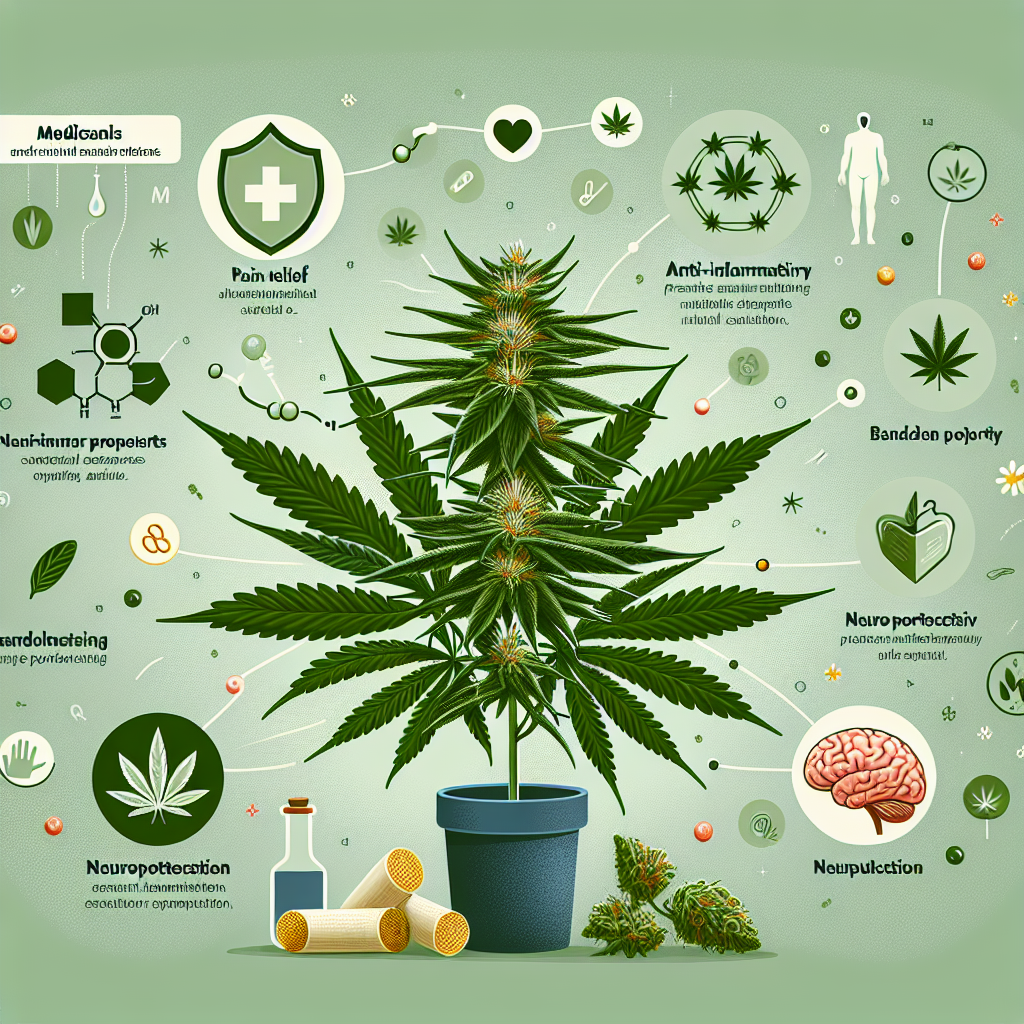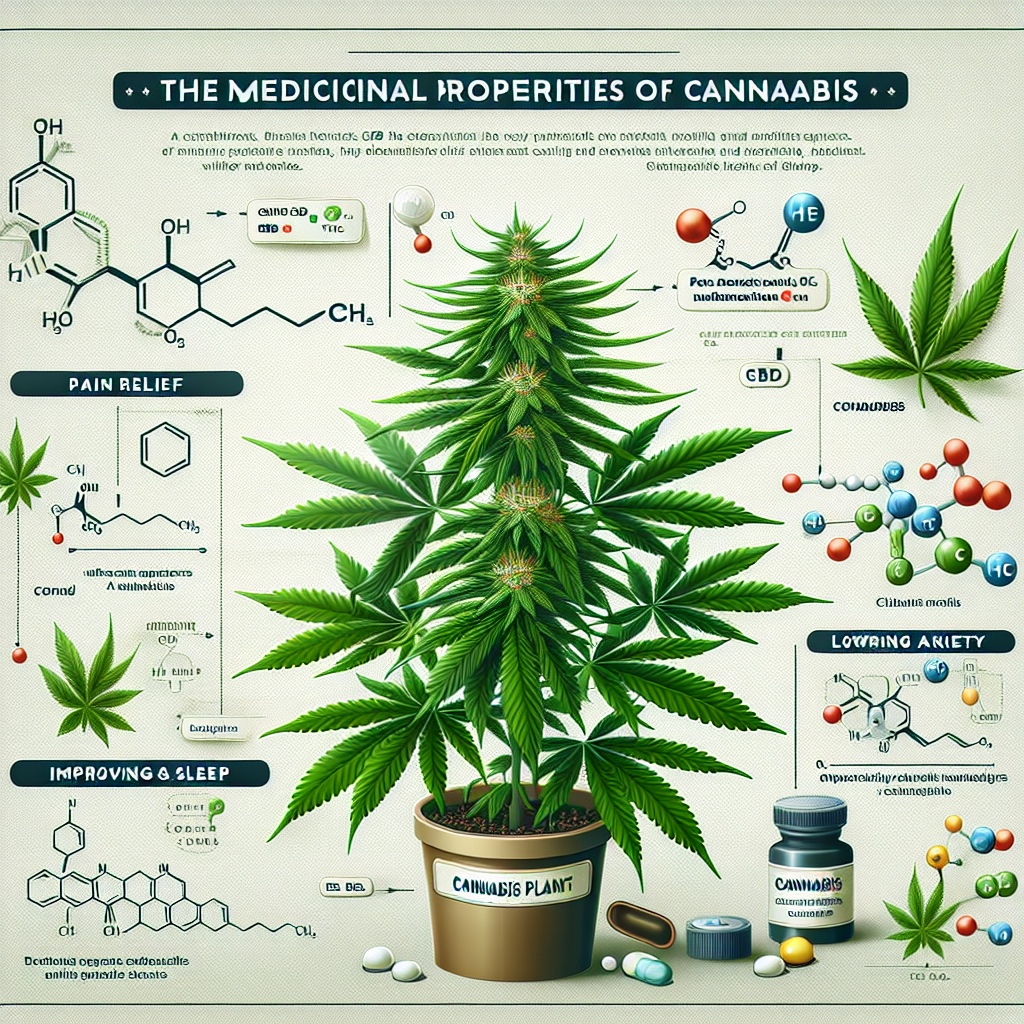Cannabis, a plant with a rich history of medicinal use, has garnered significant attention in recent years for its potential therapeutic properties. The primary compounds responsible for its medical efficacy are cannabinoids, including tetrahydrocannabinol (THC) and cannabidiol (CBD). THC is known for its psychoactive effects, which can help alleviate pain, nausea, and stimulate appetite, making it beneficial for patients undergoing chemotherapy. CBD, on the other hand, is non-psychoactive and has been shown to possess anti-inflammatory, anti-anxiety, and anti-seizure properties. Additionally, the plant contains terpenes and flavonoids, which contribute to its therapeutic profile by enhancing the effects of cannabinoids through the entourage effect. The versatility of cannabis in treating a wide range of conditions, from chronic pain and epilepsy to anxiety and multiple sclerosis, underscores its potential as a potent medical solution.
Cannabinoids: The Active Compounds Behind Cannabis’s Medical Benefits
Cannabinoids are the active compounds in cannabis that are responsible for its wide range of medical benefits. These naturally occurring chemicals interact with the body’s endocannabinoid system, a complex network of receptors and neurotransmitters that play a crucial role in regulating various physiological processes. Among the many cannabinoids found in cannabis, two have garnered the most attention for their therapeutic potential: tetrahydrocannabinol (THC) and cannabidiol (CBD).
THC is perhaps the most well-known cannabinoid due to its psychoactive properties, which produce the “high” associated with cannabis use. However, beyond its recreational appeal, THC has significant medical applications. It has been shown to be effective in alleviating chronic pain, reducing muscle spasticity in conditions like multiple sclerosis, and stimulating appetite in patients undergoing chemotherapy. Moreover, THC’s ability to modulate mood and reduce anxiety makes it a valuable tool in the treatment of mental health disorders such as PTSD and depression.
On the other hand, CBD is non-psychoactive, meaning it does not produce a high. This makes it an attractive option for patients seeking relief without the mind-altering effects of THC. CBD has been extensively studied for its anti-inflammatory, analgesic, and anti-anxiety properties. It has shown promise in treating a variety of conditions, including epilepsy, where it has been particularly effective in reducing the frequency and severity of seizures. Additionally, CBD’s neuroprotective properties are being explored for potential benefits in neurodegenerative diseases like Alzheimer’s and Parkinson’s.
The interaction between THC and CBD is also noteworthy. When used together, these cannabinoids can produce a synergistic effect, enhancing each other’s therapeutic benefits while mitigating potential side effects. For instance, CBD can counteract the anxiety-inducing effects of THC, making the overall experience more tolerable for patients. This interplay is a prime example of the “entourage effect,” a phenomenon where the combined action of various cannabis compounds results in a more effective treatment than any single compound alone.
Beyond THC and CBD, there are over 100 other cannabinoids in cannabis, each with its own unique properties. Cannabinol (CBN), for example, is known for its sedative effects and is being studied for its potential in treating insomnia. Cannabigerol (CBG) has shown promise as an anti-inflammatory and antibacterial agent, while tetrahydrocannabivarin (THCV) is being investigated for its potential to regulate blood sugar levels and aid in weight loss.
The versatility of cannabinoids extends to their various methods of administration, allowing patients to choose the most suitable form for their needs. Inhalation through smoking or vaporizing provides rapid relief, making it ideal for acute symptoms like sudden pain or anxiety attacks. Oral consumption through edibles or capsules offers longer-lasting effects, which can be beneficial for chronic conditions. Topical applications, such as creams and balms, allow for targeted relief of localized pain and inflammation.
In conclusion, the medical benefits of cannabis are largely attributed to its diverse array of cannabinoids. These compounds interact with the body’s endocannabinoid system to produce a wide range of therapeutic effects, from pain relief and anti-inflammatory action to mood regulation and neuroprotection. The synergistic relationship between different cannabinoids further enhances their efficacy, making cannabis a potent medical solution for a variety of conditions. As research continues to uncover the full potential of these active compounds, the future of cannabis in medicine looks increasingly promising.
Terpenes: Aromatic Compounds Enhancing Cannabis’s Therapeutic Effects

Cannabis has long been recognized for its potential therapeutic benefits, and much of this can be attributed to its complex chemical composition. Among the myriad compounds found in cannabis, terpenes play a crucial role in enhancing its medicinal properties. Terpenes are aromatic compounds that not only give cannabis its distinctive smell but also contribute significantly to its therapeutic effects. Understanding the role of terpenes can provide deeper insights into why cannabis is such a potent medical solution.
To begin with, terpenes are naturally occurring compounds found in many plants, including cannabis. They are responsible for the diverse range of aromas and flavors that different cannabis strains exhibit. For instance, the citrusy scent of some strains can be attributed to the terpene limonene, while the earthy aroma of others may come from myrcene. These aromatic compounds are not just about smell; they have a profound impact on the overall experience and effectiveness of cannabis.
Moreover, terpenes interact synergistically with cannabinoids, such as THC and CBD, in what is known as the “entourage effect.” This phenomenon suggests that the therapeutic effects of cannabis are not solely due to cannabinoids but are significantly enhanced by the presence of terpenes. For example, myrcene is known to have sedative properties and can enhance the relaxing effects of THC, making it beneficial for patients dealing with insomnia or anxiety. On the other hand, limonene has uplifting and mood-enhancing properties, which can be particularly useful for those suffering from depression.
In addition to their synergistic effects with cannabinoids, terpenes themselves possess a range of therapeutic properties. Linalool, a terpene commonly found in lavender as well as cannabis, is known for its calming and anti-anxiety effects. It has been used in aromatherapy for centuries to promote relaxation and reduce stress. Similarly, pinene, which is also found in pine needles, has anti-inflammatory and bronchodilator properties, making it beneficial for patients with asthma or other respiratory conditions.
Furthermore, the anti-inflammatory properties of certain terpenes can be particularly advantageous for patients with chronic pain or inflammatory conditions. Beta-caryophyllene, for instance, is a terpene that binds to CB2 receptors in the endocannabinoid system, which are primarily found in the immune system. This interaction can help reduce inflammation and alleviate pain, offering a natural alternative to traditional pain medications.
As research into cannabis continues to evolve, the importance of terpenes in medical applications becomes increasingly evident. Scientists are now exploring the potential of isolating specific terpenes to create targeted treatments for various conditions. This could lead to the development of more effective and personalized medical cannabis products, tailored to meet the unique needs of individual patients.
In conclusion, terpenes are much more than just aromatic compounds; they are integral to the therapeutic potential of cannabis. By working in harmony with cannabinoids and possessing their own medicinal properties, terpenes enhance the overall effectiveness of cannabis as a medical solution. As our understanding of these compounds deepens, so too does the potential for developing innovative treatments that harness the full power of cannabis. Whether it’s through their calming effects, anti-inflammatory properties, or their ability to enhance the benefits of cannabinoids, terpenes play a vital role in making cannabis a potent and versatile medical solution.
The Entourage Effect: How Cannabis Compounds Work Together for Greater Efficacy
Cannabis has long been recognized for its potential medical benefits, but what truly sets it apart is the synergy between its various compounds, a phenomenon known as the entourage effect. This concept suggests that the therapeutic effects of cannabis are not solely due to individual cannabinoids like THC or CBD, but rather the result of the complex interplay between these cannabinoids, terpenes, and other phytochemicals. Understanding the entourage effect can provide deeper insights into why cannabis is such a potent medical solution.
To begin with, cannabinoids are the primary active compounds in cannabis, with THC (tetrahydrocannabinol) and CBD (cannabidiol) being the most well-known. THC is famous for its psychoactive properties, which can help alleviate pain, stimulate appetite, and reduce nausea. On the other hand, CBD is non-psychoactive and is celebrated for its anti-inflammatory, anti-anxiety, and anti-seizure properties. While these cannabinoids are powerful on their own, their combined effects can be even more significant.
For instance, research has shown that CBD can mitigate some of the adverse effects of THC, such as anxiety and paranoia, making the overall experience more tolerable for patients. This balancing act between THC and CBD exemplifies the entourage effect, where the presence of one compound enhances the benefits and reduces the drawbacks of another. Moreover, this interaction can lead to a more comprehensive therapeutic profile, addressing multiple symptoms simultaneously.
In addition to cannabinoids, terpenes play a crucial role in the entourage effect. Terpenes are aromatic compounds found in many plants, including cannabis, and they contribute to the plant’s distinctive smell and flavor. More importantly, terpenes have their own therapeutic properties and can influence how cannabinoids interact with the body. For example, myrcene, a common terpene in cannabis, has sedative effects and can enhance the permeability of cell membranes, allowing cannabinoids to be absorbed more efficiently. Similarly, limonene, another prevalent terpene, has mood-enhancing and anti-anxiety properties, which can complement the effects of CBD.
Furthermore, the entourage effect is not limited to just cannabinoids and terpenes. Flavonoids, another group of phytochemicals found in cannabis, also contribute to its medicinal properties. Flavonoids have antioxidant, anti-inflammatory, and neuroprotective effects, which can enhance the overall therapeutic potential of cannabis. When combined with cannabinoids and terpenes, flavonoids can create a more robust and effective treatment option for various medical conditions.
The entourage effect underscores the importance of using whole-plant cannabis extracts rather than isolated compounds. While isolated THC or CBD can be beneficial, they may not provide the same level of efficacy as a full-spectrum extract that includes a wide range of cannabinoids, terpenes, and flavonoids. This holistic approach allows patients to experience the full benefits of the entourage effect, leading to better outcomes.
In conclusion, the entourage effect is a key factor in the medical efficacy of cannabis. By working together, cannabinoids, terpenes, and flavonoids create a synergistic effect that enhances the therapeutic potential of the plant. This complex interplay not only maximizes the benefits but also minimizes the side effects, making cannabis a versatile and potent medical solution. As research continues to uncover the intricacies of the entourage effect, it becomes increasingly clear that the whole is indeed greater than the sum of its parts when it comes to cannabis.
The Role of CBD and THC in Pain Management and Inflammation Reduction
Cannabis has garnered significant attention in recent years for its potential medical benefits, particularly in the realms of pain management and inflammation reduction. Central to these benefits are two primary compounds found in the cannabis plant: cannabidiol (CBD) and tetrahydrocannabinol (THC). Understanding the roles of CBD and THC in alleviating pain and reducing inflammation can provide valuable insights into why cannabis is considered a potent medical solution.
CBD, a non-psychoactive compound, has been widely studied for its therapeutic properties. One of the most compelling aspects of CBD is its ability to interact with the body’s endocannabinoid system (ECS), which plays a crucial role in regulating various physiological processes, including pain and inflammation. By binding to receptors in the ECS, CBD can modulate pain signals and reduce inflammatory responses. This interaction is particularly beneficial for individuals suffering from chronic pain conditions, such as arthritis or fibromyalgia, where traditional pain medications may fall short or cause undesirable side effects.
In addition to its interaction with the ECS, CBD also influences other receptor systems in the body. For instance, it has been shown to activate serotonin receptors, which can contribute to its analgesic and anti-inflammatory effects. This multi-faceted approach makes CBD a versatile option for pain management, offering relief without the risk of dependency associated with opioid medications. Moreover, CBD’s anti-inflammatory properties extend beyond pain relief, as it can also help manage conditions like inflammatory bowel disease and multiple sclerosis, where inflammation plays a central role in disease progression.
On the other hand, THC, the psychoactive component of cannabis, also plays a significant role in pain management and inflammation reduction. While THC is often associated with the “high” that cannabis users experience, it too interacts with the ECS, particularly the CB1 receptors located in the brain and central nervous system. This interaction can alter pain perception and provide substantial relief for individuals dealing with severe or neuropathic pain. Additionally, THC has been found to possess anti-inflammatory properties, making it a valuable component in the treatment of conditions characterized by inflammation.
Interestingly, the combination of CBD and THC can produce a synergistic effect, enhancing the overall therapeutic potential of cannabis. This phenomenon, known as the “entourage effect,” suggests that the compounds work better together than they do individually. For example, while THC can provide immediate pain relief, CBD can help mitigate some of the psychoactive effects of THC, making the treatment more tolerable for patients. This balanced approach allows for more comprehensive pain management and inflammation reduction, catering to a broader range of medical needs.
Furthermore, the versatility of cannabis as a medical solution is evident in its various forms of administration. Patients can choose from oils, tinctures, edibles, and topical applications, allowing for personalized treatment plans that suit their specific conditions and preferences. This flexibility not only enhances patient compliance but also ensures that individuals can find the most effective method for their unique circumstances.
In conclusion, the roles of CBD and THC in pain management and inflammation reduction highlight the potent medical potential of cannabis. By interacting with the body’s endocannabinoid system and other receptor pathways, these compounds offer a multi-dimensional approach to alleviating pain and reducing inflammation. The synergistic effects of CBD and THC further enhance their therapeutic benefits, making cannabis a versatile and effective option for a wide range of medical conditions. As research continues to uncover the full extent of these properties, cannabis is poised to become an increasingly integral part of modern medical practice.
Q&A
1. **What are the primary active compounds in cannabis that contribute to its medical properties?**
– The primary active compounds are cannabinoids, particularly THC (tetrahydrocannabinol) and CBD (cannabidiol).
2. **How does THC contribute to the medical benefits of cannabis?**
– THC is known for its psychoactive effects and can help with pain relief, muscle spasticity, glaucoma, insomnia, low appetite, nausea, and anxiety.
3. **What medical conditions can CBD help alleviate?**
– CBD is non-psychoactive and can help with conditions such as epilepsy, chronic pain, inflammation, anxiety, depression, and certain types of seizures.
4. **What is the role of terpenes in the medical efficacy of cannabis?**
– Terpenes are aromatic compounds that can enhance the therapeutic effects of cannabinoids through the entourage effect, contributing to anti-inflammatory, analgesic, and anti-anxiety properties.
Conclusion
Cannabis possesses a range of properties that make it a potent medical solution. Its primary active compounds, cannabinoids such as THC and CBD, interact with the body’s endocannabinoid system to regulate various physiological processes. THC is known for its psychoactive effects and pain-relieving properties, while CBD is non-psychoactive and has anti-inflammatory, anti-anxiety, and anti-seizure benefits. Additionally, cannabis contains terpenes and flavonoids that contribute to its therapeutic effects. The plant’s versatility in treating conditions like chronic pain, epilepsy, multiple sclerosis, and anxiety disorders, along with its relatively low risk of addiction and side effects compared to traditional pharmaceuticals, underscores its potential as a valuable medical treatment.


